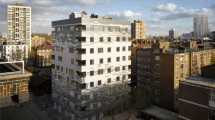Abstract
This paper presents curve estimations of the heat release rate of an intercity railcar fire. Three different estimation approaches were used, which were compared with a full-scale fire test of the car. Two of these approaches were based on the assumption of a specific burning rate of materials with the heat release rate per unit area and burning area decision. The curve of the heat release rate of an actual railcar fire was measured by using the ignition scenario in EN 45545-1. In the fire test, the surface temperature of every part of the interior was measured by using the burning area decision for summation method estimation. The third approach used combustion and reaction heat to analyze microscopic-material pyrolysis. The pyrolysis model requires more sophisticated material property inputs to achieve the same degree of curve accuracy. The differences and similarities between the experimental fire curves and estimations were analyzed.
Similar content being viewed by others
References
H. Ingason, Correlation between temperatures and oxygen measurements in a tunnel flow, Fire Safety Journal, 42 (2007) 75–80.
B. Chiam, Numerical simulation of a metro train fire, Department of Civil Engineering, University of Canterbury, New Zealand (2005).
T. Barden, J. Brown and T. Hetrick, Train fire modeling in fire dynamic simulator, Worcester Polytechnic Institute, USA (2005).
K. McGrattan, S. Hostikka, J. Floyd, H. Baum, R. Rehm, W. Mell and R. McDermott, Fire dynamics simulator version 5 technical reference guide, NIST Special Publication 1018-5, USA (2010).
Y. Ko, A study of the heat release rate of tunnel fires and the interaction between suppression and longitudinal air flows in tunnels, Ph.D., Carleton University, Canada (2011).
ISO 9705, Fire tests — full-scale room test for surface products, International Organization for Standardization (1993).
D. Lee, W. Park, W. Jung, N. White, A. Webb and J. Hwang, Two cases of interior fire tests within ISO 9705 for railway passenger coach, 11th Fire & Materials Conference Proceeding, Fisherman’s Wharf, San Francisco, USA (2009).
Author information
Authors and Affiliations
Corresponding author
Additional information
Duckhee Lee received his B.S. and M.S. in Physics from Yonsei University, Korea, in 1994 and 1997. He is currently pursuing a Ph.D. in Mechanical Engineering. He is a Senior Researcher of the Eco-Transport Systems Research Division of Korea Railroad Research Institute. His research interests include material fire test, fire dynamics, and risk assessment of railway systems.
Rights and permissions
About this article
Cite this article
Lee, D., Park, W., Jung, W. et al. Estimations of heat release rate curve of railcar fire. J Mech Sci Technol 27, 1665–1670 (2013). https://doi.org/10.1007/s12206-013-0414-2
Received:
Revised:
Accepted:
Published:
Issue Date:
DOI: https://doi.org/10.1007/s12206-013-0414-2




